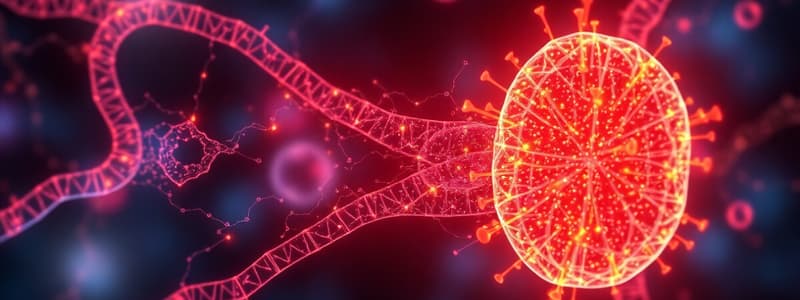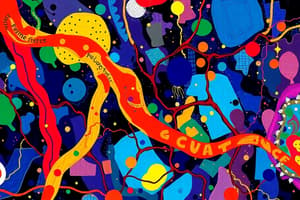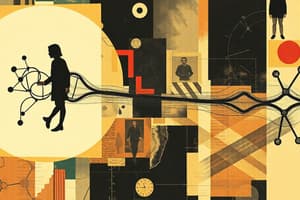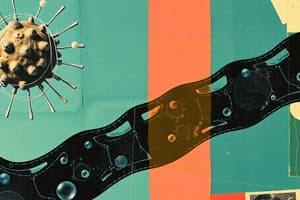Podcast
Questions and Answers
How does calcium binding to calmodulin domains impact the corresponding protein?
How does calcium binding to calmodulin domains impact the corresponding protein?
- It prevents the protein from interacting with other signaling molecules.
- It accelerates the protein's degradation, reducing its overall concentration.
- It inhibits the protein's enzymatic activity by disrupting its active site.
- It induces a conformational change, enabling the activation of the protein. (correct)
What is the primary role of Diacylglycerol (DAG) in the IP3 signaling pathway?
What is the primary role of Diacylglycerol (DAG) in the IP3 signaling pathway?
- To activate protein kinase C (PKC). (correct)
- To directly activate ligand-gated calcium channels on the cell surface.
- To trigger the release of calcium from intracellular stores.
- To inhibit the production of Inositol 1,4,5-triphosphate (IP3).
In the context of integrin signaling, what is meant by 'concomitant signaling'?
In the context of integrin signaling, what is meant by 'concomitant signaling'?
- Integrins must collaborate with growth factor receptors to initiate signaling.
- Integrin signaling is entirely dependent on prior activation of G protein-coupled receptors.
- Integrins activate other receptor tyrosine kinases to amplify the signal.
- Integrins signal independently to trigger the same downstream molecule. (correct)
How does Phosphatidylinositol-3-kinase (PI3K) contribute to insulin signaling?
How does Phosphatidylinositol-3-kinase (PI3K) contribute to insulin signaling?
Which of the following is an accurate description of 'gated mechanisms' in cellular signaling?
Which of the following is an accurate description of 'gated mechanisms' in cellular signaling?
What role does calcium play in the production of reactive nitrogen species?
What role does calcium play in the production of reactive nitrogen species?
What enzymatic activity terminates the cAMP signaling pathway by converting cAMP into 5'AMP?
What enzymatic activity terminates the cAMP signaling pathway by converting cAMP into 5'AMP?
Which of the following is the correct mechanism of cAMP formation?
Which of the following is the correct mechanism of cAMP formation?
Protein Kinase A (PKA) directly modifies proteins at which amino acid residues?
Protein Kinase A (PKA) directly modifies proteins at which amino acid residues?
How does cAMP binding affect Protein Kinase A (PKA)?
How does cAMP binding affect Protein Kinase A (PKA)?
What is the primary function of CREB once activated by PKA?
What is the primary function of CREB once activated by PKA?
Which of the following describes the role of inhibitory G-proteins in the cAMP signaling pathway?
Which of the following describes the role of inhibitory G-proteins in the cAMP signaling pathway?
A researcher discovers a mutation that prevents the alpha subunit of an inhibitory G-protein from inhibiting adenylate cyclase. What is a likely outcome of this mutation?
A researcher discovers a mutation that prevents the alpha subunit of an inhibitory G-protein from inhibiting adenylate cyclase. What is a likely outcome of this mutation?
How does Pertussis toxin affect inhibitory G-protein signaling?
How does Pertussis toxin affect inhibitory G-protein signaling?
What is the effect of Cholera toxin on the activity of stimulatory G proteins?
What is the effect of Cholera toxin on the activity of stimulatory G proteins?
Which step in the GPCR cAMP signaling pathway represents an amplification step?
Which step in the GPCR cAMP signaling pathway represents an amplification step?
What role do mediators play in signal transduction pathways?
What role do mediators play in signal transduction pathways?
How does signal amplification occur within a typical signaling pathway?
How does signal amplification occur within a typical signaling pathway?
If a signaling pathway's termination mechanism is impaired, what is the most likely consequence?
If a signaling pathway's termination mechanism is impaired, what is the most likely consequence?
Which of the following is NOT considered a major component of all signaling pathways?
Which of the following is NOT considered a major component of all signaling pathways?
What is the most likely outcome of a mutation that causes a receptor to be constitutively active (always 'on') even without ligand binding?
What is the most likely outcome of a mutation that causes a receptor to be constitutively active (always 'on') even without ligand binding?
A cell signaling pathway involves a receptor, several protein kinases, and a transcription factor. If a phosphatase that dephosphorylates and inactivates one of the protein kinases is inhibited, what would be the likely effect on the pathway?
A cell signaling pathway involves a receptor, several protein kinases, and a transcription factor. If a phosphatase that dephosphorylates and inactivates one of the protein kinases is inhibited, what would be the likely effect on the pathway?
In a signaling pathway, a protein 'X' acts as a scaffold, bringing together two other proteins 'A' and 'B' to facilitate their interaction. If protein 'X' is mutated such that it can no longer bind to protein 'A', what would be the most likely consequence?
In a signaling pathway, a protein 'X' acts as a scaffold, bringing together two other proteins 'A' and 'B' to facilitate their interaction. If protein 'X' is mutated such that it can no longer bind to protein 'A', what would be the most likely consequence?
A researcher observes that when a specific ligand binds to its receptor, it activates two distinct signaling pathways, Pathway 1 and Pathway 2, which lead to different cellular responses. However, Pathway 2 also contains a negative feedback loop that inhibits Pathway 1 after a certain period. What is the most likely purpose of this type of signaling arrangement?
A researcher observes that when a specific ligand binds to its receptor, it activates two distinct signaling pathways, Pathway 1 and Pathway 2, which lead to different cellular responses. However, Pathway 2 also contains a negative feedback loop that inhibits Pathway 1 after a certain period. What is the most likely purpose of this type of signaling arrangement?
A particular drug is designed to block the interaction between a receptor and its downstream mediator protein. What is the most likely effect of this drug on the signaling pathway?
A particular drug is designed to block the interaction between a receptor and its downstream mediator protein. What is the most likely effect of this drug on the signaling pathway?
Flashcards
IP3 Signaling Pathway
IP3 Signaling Pathway
Triggers intracellular calcium release and activates protein kinase C.
Inositol Triphosphate (IP3)
Inositol Triphosphate (IP3)
A ligand-gated calcium channel.
Diacylglycerol (DAG)
Diacylglycerol (DAG)
Activates protein kinase C (PKC) along with calcium.
Nitric Oxide Synthase (NOS)
Nitric Oxide Synthase (NOS)
Signup and view all the flashcards
Integrins
Integrins
Signup and view all the flashcards
Coincident Mechanisms
Coincident Mechanisms
Signup and view all the flashcards
Signal Transduction
Signal Transduction
Signup and view all the flashcards
3 Major Components of Signaling Pathways
3 Major Components of Signaling Pathways
Signup and view all the flashcards
Signal Amplification
Signal Amplification
Signup and view all the flashcards
Signaling Mediators
Signaling Mediators
Signup and view all the flashcards
Consequences of Altered Signaling Pathways
Consequences of Altered Signaling Pathways
Signup and view all the flashcards
G-coupled Protein Receptors (GPCRs)
G-coupled Protein Receptors (GPCRs)
Signup and view all the flashcards
Integrin Signaling
Integrin Signaling
Signup and view all the flashcards
Phosphoinositide 3-Kinase (PI3K)
Phosphoinositide 3-Kinase (PI3K)
Signup and view all the flashcards
cAMP Role
cAMP Role
Signup and view all the flashcards
cAMP Formation
cAMP Formation
Signup and view all the flashcards
cAMP Termination
cAMP Termination
Signup and view all the flashcards
PKA Function
PKA Function
Signup and view all the flashcards
PKA Activation
PKA Activation
Signup and view all the flashcards
Mediator Role of PKA
Mediator Role of PKA
Signup and view all the flashcards
CREB Activation
CREB Activation
Signup and view all the flashcards
Inhibitory G-proteins
Inhibitory G-proteins
Signup and view all the flashcards
Pertussis Toxin Effect
Pertussis Toxin Effect
Signup and view all the flashcards
Study Notes
- Signal Transduction is the focus
- Signal mediation and transduction down a pathway
Objectives
-
Identify signaling mediators for receptors or pathways
-
Emphasis is on G-coupled protein receptors, inositol triphosphate, integrin signaling, PI3K, and insulin signaling
-
Recognize steps leading to signal amplification
-
Explain how low levels of ligand lead to biological responses
-
Signal transduction is collaborative or concomitant
-
Summarize signal transduction mechanisms like coincident, gated, and feedback
-
Assess consequences of changes in initiation, propagation, or termination/reset of a pathway
-
Considering ligands, receptors, mediators, or transcription factors
-
Three major components to all signaling pathways can cause adverse consequences if altered
Basics of Signal Propagation
- Amplification happens during this signaling
- Receptors trigger mediators, which trigger additional mediators
- Mediators include proteins, ions, and phospholipids
GPCR: cAMP Signaling Pathway
- Step 1: Unoccupied receptor does not interact with Gs protein.
- Step 2: Occupied receptor changes shape interacting with Gs protein, which releases GDP and binds GTP.
- Step 3: Alpha subunit of Gs protein dissociates activating adenylyl cyclase.
- Step 4: When hormone is no longer present, the receptor reverts to its resting state
- GTP on the alpha subunit is hydrolyzed to GDP, and adenylyl cyclase is deactivated
Metabolism of cAMP
- cAMP is involved in propagation, can also be defined as signal transduction Propagation is amplification step
- Low levels of ligand activity trigger receptors
- Mediators/signal transducers increase signal at each cascade stage
- Process: intramolecular attack of 3' hydroxyl group of the ribose
- Against the alpha-phosphoryl group of ATP, phosphodiester bond
- Termination via hydrolysis of cAMP to 5'AMP by cAMP specific phosphodiesterases
Protein Kinase A
- Protein Kinase phosphorylates proteins on serine and threonine residues
- Protein Kinase binds cAMP
- Functions as a mediator
- Regulates activity of ion channels and activity of phosphatases that regulate signaling
- Protein Kinase A activates molecules like CREB -Recruits coactivator proteins and induces transcription
- Protein Kinase Also regulates depending on the activation to set the correct scene
- cAMP activates Protein Kinase to either do other jobs or express transcription factors
Balancing Stimulation and Inhibition
-
Stimulation and inhibition can be on or off depending on the product
-
Inhibitory G-proteins function like stimulatory G-proteins
-
Alpha subunit inhibits adenylate cyclase activation
-
Critical balance between Stimulation and Inhibition must be found
-
Pertussis toxin prevents the inhibitory pathway from functioning
-
Cholera toxin prevents GTPase activity, preventing GTP to GDP exchange
GPCR: IP3 Signaling Pathway
-
Step 1: Hormone binds to a specific receptor
-
Step 2: Occupied receptor interacts with Gq protein.
-
Step 3: Alpha Subunit of Gq releases GDP and binds GTP.
-
Step 4: Alpha Subunit of Gq dissociates from Beta + alpha subunits activating phospholipase C.
-
Step 5: Active phospholipase C cleaves phosphatidylinositol 4,5-bisphosphate (PIP2) to inositol trisphosphate (IP3) and diacylglycerol.
-
Step 6: IP3 binds to a specific receptor on the endoplasmic reticulum, causing the release of sequestered Ca2+.
-
Step 7: Calcium and diacylglycerol activate protein kinase
-
Step 8: Protein Kinase C catalyzes phosphorylation of cellular proteins that mediate cellular responses
-
IP3 controls Ca++ Channels
-
DAG stays on the membrane and activates protein kinase C
Inositol Signaling and Phospholipase C
- Triggering second messengers
- Inositol 1,4,5-triphosphate (IP3) triggers intracellular calcium stores
- Diacylglycerol (DAG) activates protein kinase C
- You want to trigger channels when there is a conc gradient for Ca+2 to to move down , otherwise the activity Doesn't mat
Activity of Mediators
- Inositol Triphosphate acts as the ligand for the ligand gated calcium Channel
- Diacylglycerol (along with calcium) activates PKC
Signaling and Nitric Oxide Synthase
- Production of reactive nitrogen species is triggered by calcium via calcium dependent nitric oxide synthase (NOS)
- Calcium binds to the calmodulin domain in the calcium-dependent NOS
- Binding to calmodulin results in shifts to the corresponding protein which initiates activation
Insulin Signaling
- Insulin receptor is a tyrosine kinase
- Multiple mediators can be triggered based on specific phosphorylation patterns
- Insulin signaling can be growth stimulatory (mitogenic) in nature via Ras signaling
- Phosphatidylinositol3-kinase (PI3K) signaling leads to downstream activation of serine/threonine kinase via activation of AKT
- AKT mediates metabolic effects of insulin in muscle, liver, and adipose
Integrins
- Signaling through integrins enables the ECM to influence multiple aspects of cellular behavior
- Downstream effects: cellular changes in migration, proliferation, and differentiation
- Signaling can be self-promoting: changes in gene expression for more integrins to increase the number of receptors Signaling mediation overlaps with other/growth stimulatory signaling
- Plays a vital role in wound healing
Collaborative and Concomitant Signaling
- Integrins demonstrate collaboration and concomitant signaling
- Concomitant = signal independently to trigger the same molecule
- Pathways include: Ras-MAPK, PI3K-Akt, AKT (protein kinase B), and Rho
- Collaboration = work together or one activates the other
- Integrins enable growth factor-dependent signaling of the same molecule
General Mechanisms Review
- Coincident mechanisms converge at a single unit that leads to output
- Detector differentiates between the pathways and achieve desired outcome
- Gated mechanisms represent a regulatory control of one pathway on another
- The actions of one pathway contribute to or regulate the other
- Modifies response in a cell-type dependent manner
- Feedback = modified gated mechanism
Studying That Suits You
Use AI to generate personalized quizzes and flashcards to suit your learning preferences.
Related Documents
Description
Explore signal transduction pathways, focusing on G-coupled protein receptors, inositol triphosphate, and integrin signaling. Learn to identify signaling mediators and understand signal amplification. Investigate how changes in pathway components can lead to adverse consequences.




